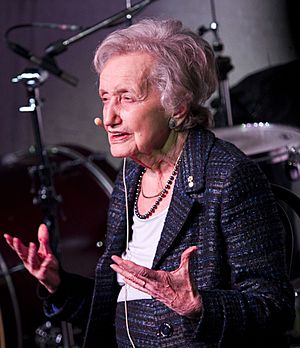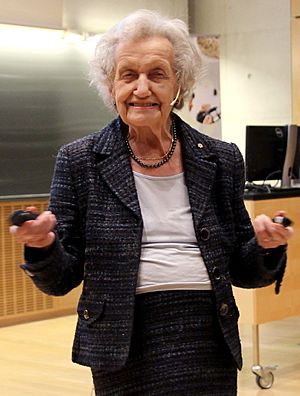Brenda Milner facts for kids
Quick facts for kids
Brenda Milner
|
|
|---|---|

Milner at TEDxMcGill in 2011
|
|
| Born |
Brenda Langford
15 July 1918 Manchester, England
|
| Alma mater | Newnham College, Cambridge McGill University |
| Known for | Study of memory and cognition; Work with patient H.M. |
| Spouse(s) |
Peter Milner
(m. 1944; died 2018) |
| Awards |
|
| Scientific career | |
| Fields | Neuropsychology |
| Institutions | McGill University, Montreal Neurological Institute |
| Thesis | Intellectual effects of temporal-lobe damage in man (1952) |
| Doctoral advisor | Donald Olding Hebb |
| Doctoral students |
|
Brenda Milner (born 15 July 1918) is a British-Canadian neuropsychologist. She has greatly helped us understand how our brains work, especially how we remember things. Milner is a professor at McGill University and the Montreal Neurological Institute. She has received many awards and continued her important work even when she was over 90 years old. Her research includes how the temporal lobes of the brain are involved in memory. Many people see her as one of the founders of neuropsychology. She received the Balzan Prize in 2009 and the Kavli Prize in 2014. She turned 100 years old in July 2018.
Contents
Early Life and Education
Brenda Langford was born on 15 July 1918, in Manchester, England. Her father, Samuel Langford, was a music critic and journalist. Her mother was one of his students. Even though her parents were musical, Brenda was not interested in music. Her father taught her mathematics and arts until she was 8.
She went to Withington Girls' School. In 1936, she received a scholarship to attend Newnham College, Cambridge, to study mathematics. However, she soon realized mathematics was not for her. Milner then changed her studies to psychology. In 1939, she earned her B.A. degree in experimental psychology.
One of her teachers at Cambridge was Oliver Zangwill. He sparked her interest in how the human brain works. She learned how important it was to study people with brain lesions (brain damage).
War Work and Moving to Canada
After she graduated, World War II began. Newnham College gave her a scholarship to continue her studies for two more years. During the war, the Cambridge Psychological Laboratory focused on helping choose aircrew. Milner's job was to create tests to help choose pilots for airplanes. She was part of a team that tried to tell the difference between fighter pilots and bomber pilots using special tests.
Later in the war, from 1941 to 1944, she worked for the Ministry of Supply. She looked into better ways for radar operators to see and control things.
In 1941, Brenda met Peter Milner, who became her husband. They were both working on radar research. In 1944, they got married and moved to Canada. Peter was invited to work on atomic research there. Brenda started teaching psychology at the University of Montreal, where she stayed for seven years.
Advanced Studies and Brain Research
In 1949, Brenda Milner earned her M.A. in experimental psychology from Cambridge. In Montreal, she began her Ph.D. in physiological psychology at McGill University. Her advisor was Donald Olding Hebb. While studying for her Ph.D., Milner and Hebb presented research on a patient named P.B. This patient had brain surgery and then had memory problems. This caught the attention of Wilder Penfield, a famous brain surgeon.
In 1950, Hebb gave Milner a chance to study with him at the Montreal Neurological Institute. Under Penfield's guidance, she studied the behavior of young adult epileptic patients. These patients had surgery to remove small parts of their brain to stop seizures. In 1952, Milner earned her Ph.D. in experimental psychology. Her thesis was about how brain damage in the temporal lobe affected people's thinking.
Professional Career
In 1954, Milner published an article about the "Intellectual Function of the Temporal Lobes." In this paper, she showed that damage to the temporal lobe can cause changes in emotions and thinking in humans and animals. Her research helped neurosurgeons understand the risks of certain brain surgeries.
Milner was a leader in the field of neuropsychology. She studied memory and other thinking functions in people. She was invited to study Henry Molaison, known as patient H.M. He became one of the most famous patients in cognitive neuroscience. H.M. had surgery that removed parts of his brain, including the hippocampus. Milner studied how this damage affected his memory. She carefully described the memory problems H.M. had.
Understanding Memory Systems
When she first worked with H.M., Milner wanted to fully understand his memory problems. She found that damage to the medial temporal lobe caused people to be unable to form new memories. They also struggled to remember things from a few years before the damage. However, their older memories and other skills like language, perception, and reasoning were still good.
For example, Milner spent three days with H.M. as he learned a new skill: drawing a star by looking at it in a mirror. He got better at the task each day. But he had no memory of ever doing it before. This made Milner think that there are different types of learning and memory. She believed each type depends on a different part of the brain. She showed there are two main memory systems: episodic memory (for events) and procedural memory (for skills).
Milner learned from H.M. and other cases that damage to certain parts of the brain causes lasting memory problems. She also showed that patients with this type of brain damage could still learn certain motor skills. This discovery was very important. It showed that our brain has multiple memory systems. Milner said that seeing H.M. learn a task perfectly but have no memory of it was an "amazing dissociation." She called it one of the most exciting moments of her life.
Frontal Lobes and Brain Organization
Milner also made big contributions to understanding how the frontal lobes help us organize information and remember things. Her research showed that the frontal lobes are key for emotional responses, hearing, memory, and speech.
She showed that a part of the frontal cortex is important for remembering the order of events. Her work also revealed that people with frontal lobe injuries often have trouble solving problems in new ways. These discoveries helped us understand that complex brain functions are spread out across different brain regions.
Milner helped describe how different parts of the human brain have special jobs (called lateralization). She showed how the brain's language areas can be different in left-handed, right-handed, and ambidextrous people. She used a test called the Wada test to show that for most people, the left side of the brain is dominant for language. Her studies were among the first to prove that brain damage can lead to the brain reorganizing itself.
In 2007, Milner donated one million dollars to the Montreal Neurological Institute. She used mostly prize money from her many awards to set up a foundation in her name.
Recent Research
More recently, Milner has used modern brain imaging techniques like functional magnetic resonance imaging (fMRI) and positron emission tomography (PET). These studies look at brain activity in healthy people. They help identify brain areas involved in spatial memory (remembering locations) and language. This includes how the brain processes speech in people who speak one language versus those who are bilingual. She has also studied the role of the right hippocampus in remembering where objects are located.
Milner continued to teach and research even after her 100th birthday. She is a professor at the Montreal Neurological Institute and McGill University. One of her current research partners is Denise Klein. They study bilingualism, looking at how the brain uses different pathways to learn new languages compared to native languages.
In 2018, Milner celebrated her 100th birthday in Montreal. She said she never expected to live so long but planned to continue for many more birthdays. The Montreal Neurological Institute held a special event in September 2018 to celebrate her achievements. That same year, Milner was part of a video series from the Institute that promotes female scientists. In the interview, she talked about her early life and career.
Awards and Honours
Milner has received many awards for her important work in neuroscience and psychology. She is a Fellow of the Royal Society of London, the Royal Society of Canada, and a member of the National Academy of Sciences. She has also received honorary degrees from over 20 universities in Canada, Europe, and the United States.
Early in her career, Newnham College, Cambridge, gave her a Sarah Smithson Research Studentship. This allowed her to continue her work there. In 1984, Milner became an Officer of the Order of Canada. She was promoted to Companion in 2004. In 1987, she received the Ralph W. Gerard Prize in Neuroscience. She also received the NAS Award in the Neurosciences in 2004 for her important studies on how the temporal lobes and other brain regions affect learning, memory, and language.
In 1985, she became an Officer of the National Order of Quebec. She was promoted to Grand Officer in 2009. In 2007, she was elected an Honorary Member of the American Academy of Arts and Sciences. She received the Balzan Prize for her work in Cognitive Neurosciences in December 2009.
Milner was awarded the Kavli Prize in Neuroscience in 2014. Other awards include:
- Election to the National Academy of Sciences (1976)
- The Metlife Foundation Award for Medical Research in Alzheimer's Disease (1996)
- Election to the American Academy of Arts and Sciences (2005)
- The Dan David Prize (2014)
- The Prix Hommage du 50e anniversaire from the Ordre des psychologues du Québec (2014)
- Induction into the Canadian Science and Engineering Hall of Fame (2012)
- A medal of honour from the National Assembly of Quebec (2018)
- The Pearl Meister Greengard Prize (2011)
- The Norman A. Anderson Lifetime Achievement Award (2010)
- The Goldman-Rakic Prize for Outstanding Achievement in Cognitive Neuroscience by NARSAD (2009)
- The NSERC Medal of Excellence (2009 and 2010)
- The Gairdner Foundation International Award (2005)
- The Prix Wilder-Penfield (Prix du Québec) (1993)
- Fellow of the Royal Society of London
- Fellow of the Royal Society of Canada
See also
 In Spanish: Brenda Milner para niños
In Spanish: Brenda Milner para niños


